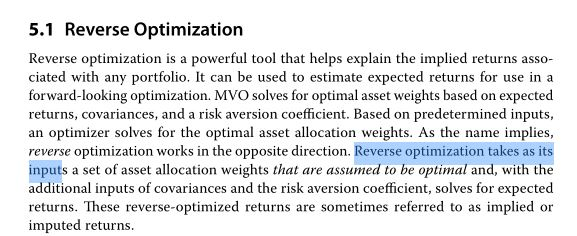NO.PZ201803130100000402
问题如下:
Contrast, using the information provided above, the results of a reverse optimization approach with that of the MVO approach for each of the following:
ii. The values of the expected returns for US equities and global bonds.
Justify your response.
选项:
解释:
The values of the expected returns for US equities and global bonds
■ For the reverse optimization approach, the expected returns of asset classes are the outputs of optimization with the market capitalization weights, covariances, and the risk aversion coefficient used as inputs.
■ In contrast, for the MVO approach, the expected returns of asset classes are inputs to the optimization, with the expected returns generally estimated using historical data.
■ The computed values for the expected returns for global bonds and US equities using the reverse optimization method are 5.3% and 9.7%, respectively.
■ In contrast, the expected return estimates used in the MVO approach from Exhibit 1 for global bonds and US equities are 4.7% and 8.6%, respectively.
The output of the reverse optimization method are optimized returns which are viewed as unobserved equilibrium or imputed returns. The equilibrium returns are essentially long-run capital market returns provided by each asset class and are strongly linked to CAPM. In contrast, the expected returns in the MVO approach are generally forecasted based on historical data and are used as inputs along with covariances and the risk aversion
coefficient in the optimization. The reverse-optimized returns are calculated using a CAPM approach. The return on an asset class using the CAPM approach is calculated as follows:
Return on Asset Class = Risk-Free Rate + (Beta) (Market Risk Premium)
Therefore, the implied returns for global bonds and US equities are calculated as follows:
Return on Global Bonds = 2.0% + (0.6) (5.5%) = 5.3%
Return on US Equities = 2.0% + (1.4) (5.5%) = 9.7%
The implied equilibrium returns for global bonds and US equities are 5.3% and 9.7%, respectively. These implied returns are above the forecasted returns based on historical data (from Exhibit 1) used as inputs in the MVO approach for global bonds and US equities of 4.7% and 8.6%, respectively.
这道题如果考试回答到什么程度就可以?感觉很广
- reverse方法算出来的return是多少
- MVO方法算出来的return是多少





